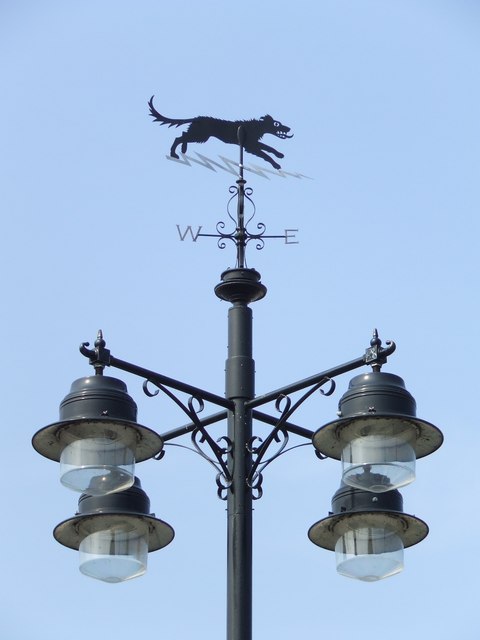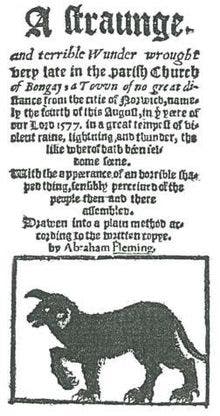For hundreds of years, the people of East Anglia have whispered tales of a large black dog with evil, flaming eyes. Sometimes these are red, other times green — and yet other times, only one eye peers from the middle of its forehead. This hellhound and its howl are seen as omens of death. The black dog has become an important visual motif in the area, especially in the town of Bungay, where it can be seen on the coat of arms, adorning weather vanes, and in the name of the local football team — The Black Dogs.

Dogs and humans share a long and close historical bond, hunting, working, playing, and living together. Over the millennia, due to this close bond, they have come to hold symbolic meanings of loyalty and protection of the home and loved ones. But one only has to look at these animals’ sharp teeth to see the predatory legacy — the capacity for aggression — of our closest companions.
So, then, what happens when the dog’s place as a guardian and companion is aligned with evil and death, with deeds done in the night that butt against the natural and proper flow of things? Folklore around the world personifies this mixture in the shape of the hellhound. In East Anglia, this mythical animal stalks under the name of the Black Shuck.
What is the Black Shuck?
First of all: is it real? I can confidently say, without a doubt, that the Black Shuck isn’t a real being. With that out of the way, it is undeniably an interesting being. Although more closely associated with the humanities than exact sciences, cultural anthropology is a very exciting and rich field of study which can yield valuable insights into the inner workings of the human minds, the lives of our ancestors, and how our societies came to be what they are today. Apart from that, the stories woven around the myth of the Black Shuck are spooky and quite cool which is, in itself, reason enough to study something.
The Black Shuck is a mythical hound-like beast told of across England, but especially in East Anglian folklore. It is particularly well-represented in the folk tales of Suffolk, Cambridgeshire, and Essex. As with all mythical beasts, there is a significant level of variation in regards to its physical features, significance, or abilities: every place and group of people will have their own twists on the story of the Black Shuck.
What everybody agrees upon, however, is that it ranges from the size of a large dog to as big as a calf or horse. It’s covered in black, shaggy fur, and can produce a terrifying, blood-curdling howl. It also likes to prowl areas that are associated with death, morbidity, darkness, or the spirit world. Fens, marshes and bogs, dark forests, empty fields, gallows, cemeteries and unmarked graves, side roads, or secluded footpaths and crossroads are its usual haunts. In the folklore of many European countries, crossroads and roads to a lesser extent were considered to be locations “between the worlds”, where spirits could manifest or be summoned.

It is heavily implied that, despite its appearance, a Black Shuck is a supernatural creature and not a regular beast.
But that’s about all people do agree on. Exactly what it wants to do, what it can do, and the rest of its appearance is up for some debate. The number and appearance of its eyes is a matter of some debate; it can have two eyes or a single one in the middle of its forehead. These can glow with otherworldly light or burn like flames — either red or green. It’s generally agreed that the Black Shuck can appear and dissipate at will, with some people holding that it can form or sublime into mist.
In Suffolk, Cambridgeshire, and Essex, for example, the Black Shuck can have multiple roles, ranging from a hellhound to a well-meaning guardian of a place or person in need. Others know it as a solid manifestation of fear, or the Devil’s own loyal dog and personal messenger.
However, for the most part, it is perceived as a creature that you’d best not cross paths with. This perception of the Black Shuck as an evil creature — or at least, one that can cause death and destruction — seeps through many of the tales that involve it. A story told by locals in Rocklands, a civil parish in the English county of Norfolk, perfectly encapsulates how this image of the Black Shuck has remained alive and well up until the present. Writing for the Lowestoft-based Borderline Science Investigation Group in their journal Lantern in 1977, UK historian and author Ivan Bunn recounts how in 1893, a sighting of the hound ended in the death of the one who saw it:
“The story is told of how at Rockland, Norfolk, one night, a man and his companion were driving along a lane ‘…when suddenly right in their path stood a huge uncanny dog. The driver pushed on in spite of his companions warning…but as the cart touched the Thing the air was alive with flames and a hideous, sulphurous stench loaded the atmosphere. Within a short time the overbold driver died and Shuck has not been seen since in these parts…'” the text reads (here, at page 3).
“One of the legendary aspects of Shuck’s character is his apparent ability in the foretelling death. The impression generally given by the legends is that everyone who encounters him will meet with some misfortune usually death, within a short time, or else somebody close to them will (although some versions of the same legend do insert what could be termed an ‘escape clause’ whereby misfortune only befalls them if they mention their encounter within 12 months). As with other aspects of the Shuck legends, for out of a total of 74 stories so far collected, only 17 instances of death followed when the witness actually attributed the death to the encounter with the appearance of Shuck.”
As far as the name is concerned, there is quite a bit of debate and uncertainty regarding the roots of the word ‘shuck’. The two main theories are that the term was either inherited from the Anglo-Saxon ‘scucca’, meaning ‘demon’, or possibly from the local dialect word shucky meaning “shaggy” or “hairy”.
Sightings of the Black Shuck

The legend of Black Shuck is extremely old. The earliest known record of the take comes from 1127, in the form of a sighting reported in the Peterborough Chronicle.
But one of the most notable reports of this unnatural black dog was written down by Abraham Fleming in The reporte of a straunge and wonderful Spectacle. The story hails from the (then-villages) of Bungay and Bythburgh in Suffolk in August of 1577. During a violent storm, the parishioners in Bungay gathered at the church for “service and common prayer, according to order”.
“The [rareness and suddenness] of the storm, consisting of [rain] violently [falling], fearful flashes of lightning, and terrible cracks of [thunder], which came with such […] force and power,” Fleming recounts of that terrible storm.
“To the [perceiving] of the people, at the time and in the place [above] named, assembled, the Church did as it were quake and [stagger], which struck into the [hearts] of those that were present, such a sore and [sudden fear], that they were in a manner robbed of their right wits.”
Against this fearful backdrop, the Black Shuck is said to have broken through the doors of the church with a clap of thunder. It then ran among the awe-struck congregation with “great swiftnesse and incredible haste”. It broke the neck of two of the faithful “in one instant”, killing them where they kneeled praying.
After this, the Shuck bit another man whose skin “[drew] together and shrunk up as it were a piece of leather scorched in a hot fire; or as the mouth of a purse or bag drawn together with a string”. This man, according to Fleming, did not perish.

While this was taking place and the”tempest lasted, and while these storms endured” he explains, the church was “so darkened [with] such a palpable darkness, that one person could not perceive another, neither yet might discern any light at all though was it lesser to the least, but only when the great flashing [of lightning] appeared”.
The “Clark” of the church — this may have been a caretaker or one of the priests — who was busy “cleaning the gutter” of the building during this storm also fell from its roof on account of the violent weather; the Shuck came upon him, Fleming writes, but he escaped unharmed either by the fall, or the beast. “[This may] sound against the truth, and to be a thing incredible; but let us leave thus or thus to judge”, he concludes.
One part of Fleming’s account takes a surprising turn. He calls the Shuck’s visit an “example of God’s wrath, no doubt to terrify us that we might fear him for his justice, or pulling back our footsteps from the paths of sin, to love him for his mercy”. This line is seemingly at odds with the brutality with which the scene is presented and seems to paint the Black Shuck as an agent of the divine, rather than the demonic hellhound local traditions paint this animal as being.
As for proof of this event — “which to some will seem absurd, although the sensibleness of the thing itself confirms it to be a truth” — Fleming cites the marks the Shuck left in the stones of the church’s floor, and in its door, “which are marvelously rotten and torn, the marks as it were of his claws and talons”. Apart from this, the internal mechanisms of the church’s clock, “all the wires, the wheels, and other things belonging [to it]”, were all “asunder and broken in pieces”.
Black Dogs
The Shuck is just one example of Black Dogs, supernatural, spectral, or demonic dog-like beings. These are primarily seen in English folklore, but certain examples of them are also seen in other parts of Europe or the Americas. They are recognized as folkloric motifs, underscoring their symbolic significance.
Although all Black Dogs are seen as malevolent actors or associated with the Devil or the demonic, it is only the Black Shuck and the Barghest of Northern England that are considered to be actively, directly harmful to people. Very few examples, such as the Black Dogs in the Somerset areas, are considered to be benign or even benevolent beings, acting as guardians of important places or safeguarding travelers.
Mythology is rife with examples of dogs associated with the idea of death — such as, for example, Cerberus, the three-headed guardian of the Greek underworld. It is possible that this association was cemented onto the scavenging behaviors of wild dogs. Black Dogs could, in turn, be a further refinement of this association.
In Europe, animals similar to the Black Dog appear in stories from France, Belgium, and Italy, while German and Czech folklore holds that the devil can sometimes appear in the shape of a black dog.
In the Americas — both North and South — the myth of the Black Dogs sailed in alongside colonists from England.


